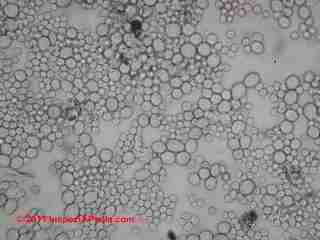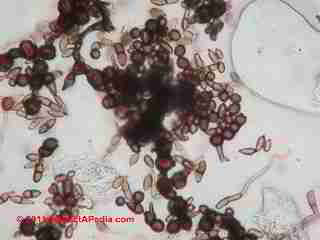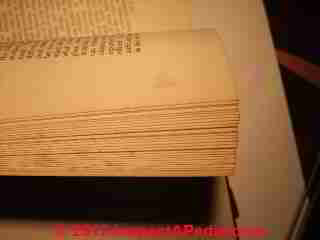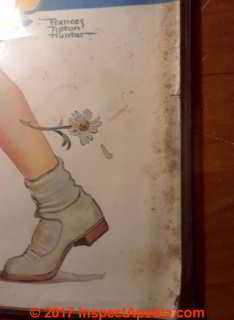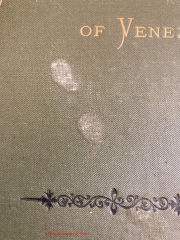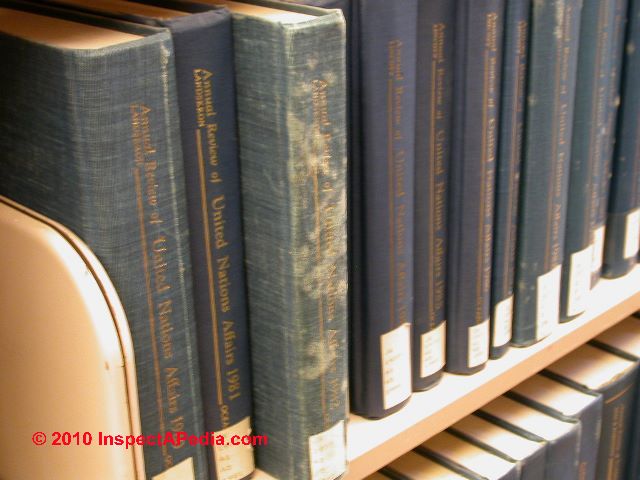 Mold Contamination on Books, Paper, Photos
Mold Contamination on Books, Paper, Photos
Remove mold stains & foxing on books
& papers
- POST a QUESTION or COMMENT about mold contamination on books, papers, libraries, documents
Mold contamination on or in books, magazines, photographs or other paper products:
This article explains how to deal with mold on books and papers, and what options we have for cleaning or storing moldy books.
The moldy books in a college library (photo above) were in the opinion of some people "an old inactive mold problem" but see our warning below about "dormant mold".
The extensive range and area of moldy books in this library was capable of producing very high (and unsafe) levels of harmful mold spores.
InspectAPedia tolerates no conflicts of interest. We have no relationship with advertisers, products, or services discussed at this website.
- Daniel Friedman, Publisher/Editor/Author - See WHO ARE WE?
Moldy Books and Papers - Can I Save Moldy Books?
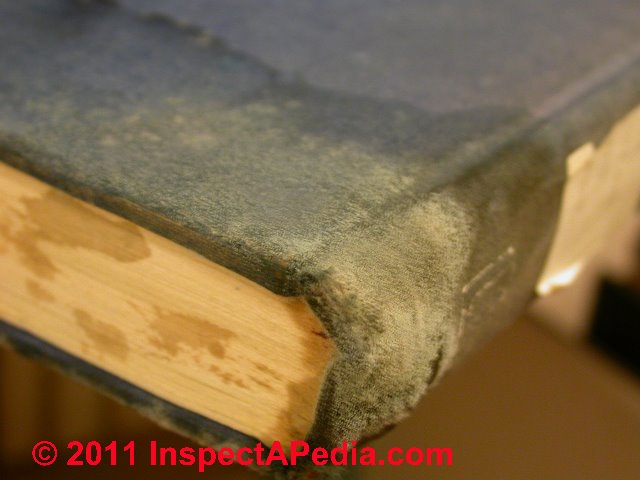 Is it possible to get rid of mold in books?
Is it possible to get rid of mold in books?
I have mold disease and I'm wondering if it's at all possible to get rid of mold in books or if I need to give them all away. Should I even try? - E.A.
[Click to enlarge any image]
Article Contents
Answer:
OPINION: A competent onsite inspection by an expert usually finds additional clues that help accurately diagnose a problem, so it could be dangerous to assume that the moldy books are the only or even the most serious mold problem in your home.
Watch out: as you indicate that you personally have a mold-related illness, you should not attempt a mold cleanup project yourself without first checking with your doctor. Most likely the physician will tell you to keep your hands off of mold stuff, and to have a professional handle the cleanup (negative air, dust control, containment, etc).
See DO-IT-YOURSELF MOLD CLEANUP WARNINGS.
Also see MOLD RELATED ILLNESS SYMPTOMS.
As we explain at MOLD AGE, HOW OLD is the MOLD?, especially in older buildings where there has been a recent sudden leak event associated with mold growth, it is often possible to identify pre-existing mold as well as mold-producing conditions.
Considerations When Preparing to Clean or Salvage Moldy Books or Papers
That said, here are some things to consider when deciding to clean or scrap moldy books or papers:
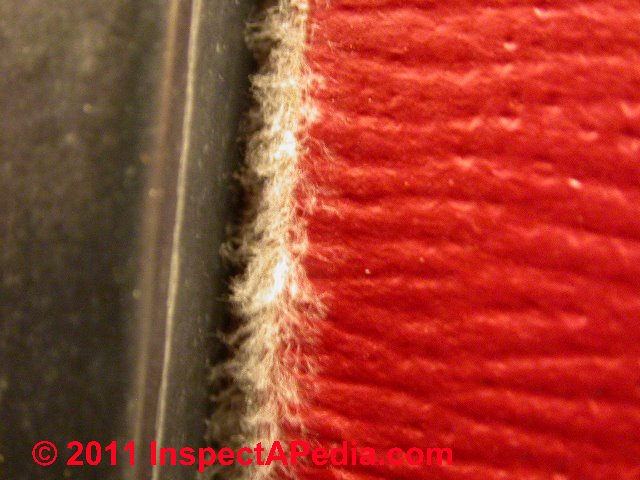
- First inspect the books carefully
(or have someone not mold sensitive do that inspection - see our warnings below).
IF mold is only on the book exterior, you can probably wipe down the book exterior or brush the book exterior.
You could use any household cleaner, even water. We're not trying to kill the mold, we're trying to remove it. If you can remove loose mold from the book exterior it wont' hurt if some stains remain. - As a DIY book mold removal project,
some folks have successfully cleaned books that suffered just exterior mold, but it may leave a moldy smell in some or all of the books even when there is no longer visible mold. - How we should clean the book exterior:
take your books outside for cleaning on a dry sunny day.
But work in the shade. Excessive sun exposure can damage books by fading and warping. (OK so if it's just one book I clean it in the kitchen.)
The book exterior is lightly brushed, or much better, HEPA (High Efficiency Particulate Air - a filter system that traps very small particles) vacuumed, gently so as not to damage the book.
Watch out: if you try using an ordinary household vacuum that is leaky and especially not HEPA rated, you will be aerating small mold spores, creating a potential health hazard and sending potentially harmful dust throughout the building.
If you do not have access to a HEPA-rated vacuum cleaner, you may have some book cleaning success using a "magnetic" wiping cloth such as Swifter Sweeper Dry Sweeping Cloths [REFERENCES] , un-scented but be careful to avoid using wipes that are themselves dampened with a chemical, cleaner, or perfume - see our next warning below.
AtReferences or Citations we list book water disaster procedures, book conservation articles, and cleaning and HEPA vacuum supply sources.
For certain sticky deposits found on some book exteriors (candy, sugar) we used a very slightly-damp steri-wipe or disposable cloth to wipe the book exterior.
Use alcohol to clean off mold?
Some book mold cleaning articles recommend using a wipe dampened with ethyl alcohol - enough to clean but not so much as to make ink run. An advantage alcohol has over water is its rapid and easy evaporation - there is no risk that the alcohol-wet paper is going to invite mold growth.
Alcohol wipes work best on glossy hard-surfaced clay-coated papers such as some magazines and on paperback books.
Watch out: we do not recommend the advice we've read by some who advise using a damp sponge to wipe the book.
Using our portable field lab we monitored a major book cleaning operation conducted for a U.S. National Park Service facility in New York. According to book conservation experts such as the Department of Preservation & Collection Maintenance, Cornell University Library:
- Do not wipe your books with any cloth treated with wax, liquid, or perfumes; chemical additives may harm your books.
- Test results for "cleaned" book surfaces:
We inspected and tested (by collecting surface samples of dust and debris) the level of mold on individual books before treatment and after each stage in the cleaning procedure - an initial wipe-down and an final outdoor wipe down and HEPA vacuum.
We found that mold was distributed at high levels uniformly over books leaving the cleaning station.
On investigation we found that the workers at the cleaning station were dipping a sponge (or rag) into a bucket of "disinfectant", then wiping each book, then rinsing the sponge/rag in the bucket again, then wiping the next book.
The result was that mold and fungal hyphae were quickly spread rather uniformly over every book that was processed - in some cases the level of book mold contamination was actually increased!
The solution was to use a disposable wipe or clean rag, wipe the book, and throw the wipe away or fold the clean - Vacuuming moldy books:
is a procedure we like, and we've also see references to using an "electrostatic duster" to clean the surface of books, but
Watch out: similar to our warning above about wiping books with a contaminated sponge or rag, we have sometimes found that a vacuum brush itself can become mold-contaminated and may spread mold from one surface to another.
However it may be possible to lightly vacuum book exteriors and the edges of moldy pages with the book closed, sufficient to significantly reduce the level of loose mold before then continuing with a wiping procedure. - If the book interior pages are moldy,
simple exterior book wiping won't do the trick. There are services that can clean moldy books but it's expensive, especially if mold is on more than the book exterior.
Treatment of individual pages of a valuable book absolutely needs to be performed by a conservator or other expert.
Just going at the book with bleach and rags can damage the book and even spread moldy debris throughout otherwise previously clean pages, just as we warned above about cross-contaminating one book exterior from another. - Freezer treatment, Heat Treatment, or Microwave treatment for books:
Some of our clients and readers have tried do-it-yourself mold cleanup methods like putting their moldy books in a freezer for a week or two to see if they can dryout and "kill" the mold.
Experts may use a "freeze-dry" system combined with cleaning.
Watch out: We are doubtful that a simple "overnight" treatment of a book in a freezer will be sufficient. Microwaving (heat) might also kill mold but it may also damage the book. And again, it's a mistake to try to "kill" mold when what's needed is to remove it. Even "dead" mold spores may be toxic or allergenic.
See MOLD KILLING GUIDE.
- Heat treatment
to attempt to deactivate mold, insects, bedbugs, etc. is often used for books, papers, even furniture or carpets.
Exposure to temperatures at or above 180F for as little as an hour has been reported [citation needed] to be effective. - Microwave treatment
for books or furnishings is similar to more conventional heat treatment but may not be viable for products that contain metal, including metallic glazes, gold leaf, etc. - Freezer treatment
for moldy books & papers offers a potentially significant advantage in that it avoids the deterioration that may occur to books, papers, artwork or other items when subjected to high temperatures.
However the procedures we have reviewed also require more time for freezer treatment (often at temperatures around -18F) than for heat treatment approaches.
- Heat treatment
- Foxing stains on books, papers & photos:
reddish brown stains observed on book pages, paper edges, and on other paper documents & photographs are caused by a combination of humidity, mold colonization by certain genera/species, and paper chemistry including the presence of iron oxide.
Details about foxing are
at FOXING STAINS on BOOKS & PAPERS.
Details about conserving moldy photos are
at MOLD on PHOTOGRAPHS, CLEAN-UP - After treatment by freezing, drying,
or fumigating (?), books are then individually steri-wiped, HEPA vacuumed, and inspected. This treatment includes not just the book exterior, but its interior pages - that's why hiring a professional to clean and restore books is costly.
See MOLD CLEANERS - WHAT TO USE. - Sun Treatment for Moldy-smelling books:
That remaining musty or moldy smell or book odor, even after cleaning, will be a mold volatile organic compound or MVOC is itself a health or irritant problem to some people, especially someone who has become sensitized to mold, is asthmatic, or has other illnesses or fragile health.
We have found that you can often significantly reduce MVOC levels and mold odors in cleaned books by placing them in sunlight but
Watch out: book conservators warn against leaving books in the sun. The sun will also warp and damage book covers, especially wet or damp books, and heaven forbid if it rains while you've left your books outside.
See MVOCs & MOLDY MUSTY ODORS. And remember, the object is to remove the mold, not "kill" it. - Valuable books: may be re-bound.
If the book or books is or are valuable, and if the book binding is in poor condition as well as moldy, it may make sense to have the moldy binding removed, the book interior cleaned, and the book then re-bound. But this is certainly too costly for an ordinary home library. - Storing books after mold removal:
Some of our clients decided to keep valuable moldy books after drying them, vacuuming, wiping the books themselves.
But because the books smelled, they were permanently stored in air-tight plastic bins. The bins were opened and the individual book aired out when needed. Another client constructed a dry, air-tight bookcase with sealed doors for storage of their cleaned de-molded books. Be sure that the book container itself is dry and clean.
After examination and brief use, the book was returned to the airtight storage bin. - Other steps to prevent books from becoming moldy,
besides storing them in a dry airtight container will start with a focus on storing books where they are not exposed to water or high humidity.
Watch out: for desiccants: We have read suggestions to use silica gel or other moisture-absorbing materials to try to keep stored books dry - it sounds like a great idea but we've seen some poor results when folks bought the silica gel, placed it and forgot it.
Because the material is hygroscopic, it can ultimately become a soup that stops absorbing moisture and instead starts giving it back to the books.
We prefer to maintain humidity, where necessary, by removing unwanted moisture sources (leaks, poor venting) and using a dehumidifier.
See HUMIDITY CONTROL & TARGETS INDOORS.
So ultimately, if the books are valuable, some of them may merit professional cleaning. Otherwise, unless the mold on your books is superficial, it's more likely less costly to dispose of the moldy books and purchase new clean dry copies.
Dormant book or paper mold problems?
We have also read book mold cleaning articles recommending that you make the mold go "dormant" so that it's dry and powdery.
That makes some sense insofar as it's easier to vacuum or wipe off a dry powdery substance than damp moldy surfaces.
And while we wouldn't call it a "dormant" state, the ongoing growth of mold may slow or even stop if conditions are no longer favorable for the particular species present - for example, if the books are dried and kept at sufficiently low humidity. But be sure to see our health hazard warning immediately below.
Health Hazards of Moldy Book Collections: Clouds of Mold Rose from the Library Book Shelves

Watch out: The moldy books in a library (photo at page top and at left) were in the opinion of some of the parties "an old inactive mold problem".
But when workers began dehumidifying the area in preparation for a mold cleanup, conditions actually got quite dangerous:
there were so many moldy books with such thick mold growth that visible clouds of Aspergillus sp. spores were released into the air by small air currents caused by simply walking down the aisle between stacks of books.
On book bindings we found heavy growths of Aspergillus sp. and on some books, Cladosporium sp. Not surprisingly, mold growth density varied significantly from book to book, even among adjacent books, depending on the binding materials.
Lab Photos of Book Mold from a Library
Our book mold lab photographs made from samples at the project above show dense Aspergillus sp. spores from a book binding surface (second photo below) and Cladosporium sp. fungal spores (below right) from a different book binding.
Very high levels of airborne Aspergillus sp. were found in the book storage area after the dehumidifiers began operating and before the cleanup had begun.
Below: Cladosporium spores and hyphal fragments:
Properties of Typical Library Bookshelf Dust
By contrast, our lab samples and photos of typical dust found on bookshelves in areas of a library that were not mold-contaminated were more like typical house dust.
The dominant library dust particles were paper fibers, carpet fibers, skin cells and of course a few pollen grains and isolated fungal spores.
In our photo of typical library bookshelf dust (below left) that large particle is pine pollen. In older sections of a library and in basements, insect fragments and elevated levels of dust mite fecals.
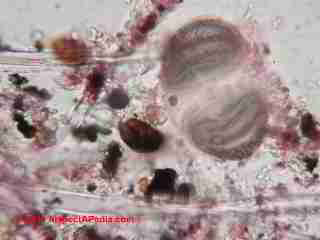
Is there Ever Mildew on Books?
No.
Continuing from the comments on mold and mildew, where renovations had gone on nearby in the building, we found non-fungal granular debris typical of plaster or drywall dust (photo below right).
We have seen several articles that refer to mildew on books. Those writers are almost certainly technically mistaken. Mildew (a much smaller subclass of members of the mold family) is an obligate parasite that grows on living plants - like grapes.
So unless your books are bound in grape leaves, the fungal growth found on books and papers is indeed mold, often Aspergillus sp. (especially on bindings) or other problem molds, but it's not actually mildew (Oidium-Erysiphe - powdery mildew, or Peronosporaceae - downy mildew).
Causes of Foxing or Rust Stains in Books or on Paper
Question/Comment: what causes rusty stains or foxing marks on books and paper ? Foxing definition, chemistry, causes, treatments or removal methods, and prevention
Are foxing marks on books and paper always caused by mould or are other factors also at work? Also, I have a couple of books with shiny pages that have become sticky during a humid summer and have developed orange lines along the edges of some of the pages.
Is this a reaction of the acid in the books seeping through the cut edges or could mould be a factor? - Rachel 9/2/202
Reply: iron oxide, fungi and yeast associated with foxing on books and papers: causes, cures, prevention
Rachel,
Your surmise that more than mold is at work in the development of local discoloration or reddish-brown foxing marks on paper and books is correct in that at the core, foxing is caused by exposure of those materials to high humidity, and the brown stains characteristic of foxing marks are typically found to contain high levels of iron oxide (FeO) in one or more chemical forms.
Paper chemistry as well as chemistry of inks and other materials comprising the book, paper, stamp, or other foxed document are also important components in the foxing problem. (Carter explains that the general yellowing of some paper products is distinct from the localized red-brown stains associated with foxing. [36][37])
Please see our detailed article that includes a more complete answer to your question, found
at FOXING STAINS on BOOKS & PAPERS.
Watch out: Tronson warns
There has been no definite cure for neutralising the mildew [properly, mold not mildew - Ed] spore, chemical use not only breaks down the paper cellulose but also reactivates the ink so not only do the fibres of the paper break down, after a while and the paper starts to disintegrate and the ink or what ever medium can be rubbed off!
...
Bleach treated or chemical treated papers on the other hand will always be subject to the foxing returning and eventual disintegration. [25]
Question / Comment: distinction between "mold" and "mildew" is questioned
This discussion has moved to a separate article now found
at MILDEW on BOOKS? - no, it's NOT mildew.
The full discussion of the problem of calling mold mildew is
Reader Question: what's the best way to remove mold from a book?
I realize that you generally restore items for people, but I'm in a heck of a bind and am hoping that you can advise me. I have a book with green mold on the paper and need to remove the stain as much as possible. As it is to be for Christmas, I can't let it go the way it is.
Is there any truth at all to ethyl alcohol or a diluted bleach solution being effective? I would be very careful not to wet the paper too much... Any information would be sincerely appreciated as I really am in a tough spot. Thanks in advance for any insight, - S.J. 12/15/12
Reply:
SJ, in addition to the article above on book mold, check the expert citations in the references below, and also take a look at the cleaning suggestions also found for a different staining material found in foxing on books and papers -
Reader Question: can a homeowner clean moldy books?
Thank you for your excellent website concerning mold, it has been most useful.
We have some specific questions concerning mold on some of our books and will be happy to pay you for your time to advise us.
A little background first. We live in an un-airconditioned house (first construction started 1982) in Saugerties, NY.
Interior relative humidity in the summer can run as high as 90-100%. In the winter with the wood burning stove operating full time the average season long humidity is 25%-30%. Several years ago my wife started to develop rather sever reactions (stuffed up ears, cough, runny nose, tightness in chest) which we attributed to mold in the house.
A year ago last summer we had a mold remediation contractor go over the entire house-we disposed of a lot of potentially moldy stuff, moved most of our books out of the house and the reactions seemed to lessen to a great degree.
We now run a de-humidifier in the sealed crawl space keeping the summer humidity in this area below 55% RH since the remediation contractor felt that a lot of the problem was coming from the crawl space. This winter we started to bring some of our books back into use and my wife started to experience the symptoms again.
From your website it seems that hepa vacuuming of the exterior of the books is the first step- my questions are as follows: - J.K. & J.W. 11 Jan 2015
... [questions & our replies are below]
Reply: tips for DIY moldy book cleaning
Kudos for asking really good questions. I'll try a succinct reply and you can let me know what more you need to know.
Should we change the brush on the wand of the vacuum very frequently to avoid spreading the mold with the brush?
You're right about the chances of spreading mold. First be sure it's a HEPA vacuum or you'll make significant airborne mold levels.
I'd Vac the books outside if you can and when weather permits. Rather than changing the brush I'd physically remove as much mold and dust as you can, then use disposable clean wipes, folding as needed but do not move a moldy wipe on to the next book.
Can we kill any remaining mold by storing the books in an unheated area during the winter? If so, what temperature do we need to maintain and for how long?
Killing mold is not effective - you need to REMOVE the mold and correct the conditions under which it grew - "dead" spores may still contain mycotoxins, allergens, and possibly other trouble.
For books that have not been opened or used during the several year long contamination period should we expect the mold to be inside the pages or just on the surface of the exterior?
In the moldy library where I examined a great number of books, mold caused by recent area conditions tended to be on the book exteriors. Older books or books that were wet are more likely to have interior mold or foxing.
Examine each book to decide how much attention it needs and to decide if the cost and trouble of cleaning are justified. Moldy, superficially-cleaned books that are of some value but that you don't want to have professionally treated can, once cleaned as much as you can clean them, be stored dry in dry air-tight containers if necessary, pending other use or steps.
What should we use to wipe the books down with after the vacuuming? Is a cloth lightly dampened with water just as effective as any thing else?
Disposable sterile wipes are probably best. I saw significant cross-contamination when a mold remediator tried wiping many books with the same cloths even though they were rinsing them.
See MOLD CLEANERS - WHAT TO USE
Can a non-scientist check for mold on books using a good light microscope and the photos from your website? If so what is the procedure? What concentration of mold or mold spores is acceptable for a household environment? (I am assuming that no-matter-what we will not be able to completely eliminate all microscopic evidence of mold)
If you see visible mold you'll recognize it - or see our photos of what mold looks like on surfaces. If you physically remove dust and debris and visible mold you're doing what a lay person can reasonably do.
A non-expert won't be able to make reliable microscopic examination of books or dust for mold though you might recognize some mold genera/species.
Are there other ways of checking for mold short of sending in tape strips to a pay-for-services company?
Visible inspection.
See MOLD APPEARANCE - WHAT MOLD LOOKS LIKE
Other methods such as air tests and cultures are unreliable when negative tests are obtained. Those problems are discussed
at MOLD TESTING METHOD VALIDITY
Should we definately start dehumidifying the living area of the house during the high humidity seasons? Can you recommend a specific brand and/or type of de-humidifier?
Yes, no.
Reader Question: is this mold on a 1941 magazine I've purchased?
I have attached some photos of a magazine from 1941 which has brown spots on the cover, mostly around two edges. Are these mold?
If so, can it be brushed off and then gently wiped with an alcohol solution? The magazine is stored in a clear plastic cover.
When I pulled it out there was no dampness. I hope that's enough info. - Anonymous by private email 2017/08/21
Reply:
Your photos of Frances Tipton Hunter's cover illustration for The Saturday Evening Post issue of April 12, 1941 have vari-colored deposits that look like mold, not "foxing". It will be difficult to completely remove all of the mold stains unless the magazine were so valuable as to merit paying a paper conservator to do that work.
Starting at BOOK / DOCUMENT MOLD & WATER DAMAGE RESTORATION we list a series of suggested steps that can remove mold, though probably not entirely, from the old magazine in your photos.
If you remove the surface mold, even if just by gentle wiping with a tissue or paper towels, and if you follow that by keeping the magazine dry and in a cool dry location, I would not expect the mold problem to get much worse.
There could be, however, some bleeding of chemicals that are already in the paper, especially if it is exposed to high humidity.
Moldy Magazine Cleanup Tips
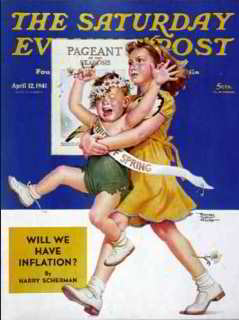
We note that this issue of The Saturday Evening Post sold for five cents when it was published in 1941. I'd wager that even sporting mold, your copy of that issue cost a bit more than that.
Here we show a cleaned-up image of the cover of the same issue of your magazine.
Watch out: What I describe below is suitable for a non-critical clean-up job of an old magazine or photo that you want to preserve. If you have a document, book, photographs of great value or of significant historical importance, take it to an expert paper conservator for treatment or at least for advice.
Based on some tests I did during a government cleanup of moldy paper goods at a historic site, I emphasize the importance of not back-contaminating or cross-contaminating surfaces even during a simple wipe-off the mold procedure.
- Personal protection:
if dealing with more than a trivial amount of mold, an expert would wear a HEPA respirator or an N95 mask (less effective), nitrile gloves, etc.
Watch out : at the very least, do not get moldy crud on your fingers and then wipe the moldy fingers in your eye. You can get a nasty fungal infection of the eye.
- Diagnose it:
first, are we looking at mold, dirt, or foxing? It matters because the choice of cleanup methods will vary depending on both the material to be cleaned (cloth, paper, type of paper) and on what contaminants are present (mold, foxing, grease, other stains).
Here we proceed with the assumption that it looks and smells like mold - we're not looking at foxing on paper.
See FOXING STAINS on BOOKS & PAPERS for more about that distinction.
- Dry it:
First be sure that the magazine is completely dry.
- Do no harm:
Second, try these methods (below) initially on an unobtrusive area of the magazine to determine that you're not making matters worse and also to confirm that the paper is not so fragile that you cannot handle it without it falling apart.
My old Civil War era newspapers are quite tough, that's because they were printed on rag paper. The Saturday Evening Post paper will have been produced much later and it is more fragile.
- Do not cross-contaminate:
Use clean cotton balls or if the paper is more-fragile, use a soft brush to loosen what you can (brush to edges) or use soft tissues.
After wiping an area that's moldy, before moving on to another section start with a new clean tissue or cotton ball. Do not re-use the same wipe across multiple pages.
What we're avoiding is smearing a thin coating of moldy dust and debris into other areas of the paper surface you're cleaning. That think coat of moldy spores, even dried out mold, not only spreads dirt and crud, it also inoculates those areas to invite worse mold re-growth should the magazine spend time in humid conditions.
Watch out: do not try using facial tissues nor bathroom tissue (toilet paper) if the product is scented or coated with a lotion - that may leave harmful deposits on your magazine.
- Wipe towards edges: Fold the tissue or paper into a 4-6" square, wipe gently from the center towards the edge of the paper.
- Remove stubborn stains from magazine paper: Paper conservators might recommend using clean water along with a few drops of dish detergent to dampen a soft cloth to dab at stained areas to see if you can remove them.
The conservator might then follow more dabbing with liquid designed to bleach out stained areas: a 1:1 or 2:1 mixture of clean water with lemon juice, hydrogen peroxide, or a dilute bleach solution. Alcohol sometimes can help remove oily stains.
Watch out: All of these treatments also involve risks including the risk of bleeding a stain out into more of the paper, or over-bleaching and damaging the paper by oxidizing it. When I've tried them I use a cotton swab and do some test dabbing in a safe area first.
Whenever I've used a bleaching agent I take care to follow up with removing the bleach with repeated dabs of clean water so as not to leave an oxidizer on the paper, followed by another step to blot the paper as dry as I can get it, followed by keeping damp pages separated until they're dry.
Watch out: I'm also nervous about even plain water since water can easily re-activate mold spores and can cause new growth if you don't dry the work out quickly enough. (Wet for 48 hours is an engraved invitation to mold formation.)
Watch out: a paper conservator would, of course, follow more expert and more-rigorous methods using a soft brush like a new clean artist's brush to wipe dried mold off of the surfaces into scrap paper that will be folded into the trash. We refer to more expert methods and sources in this article series and there is more information atReferences or Citations .
...
Reader Comments, Questions & Answers About The Article Above
Below you will find questions and answers previously posted on this page at its page bottom reader comment box.
Reader Q&A - also see RECOMMENDED ARTICLES & FAQs
Is this mold damage on this 19th Century Book?
Thank you for such an informative and helpful site. I’ve kept a 19th-century book in the paper bag it was in from the bookseller for about 1year, in a small room, which can have a damp issue now and again. I simply can't recall if the book looked damaged when I received it.
Does this look like a mould/rot the issue to you? If so, would I need to take to some from of conservator? There is a very slight musty smell but it's not overwhelming.
My antique book: Recollections of Four Years in Venezuela - On 2022-09-10 by Anonymous by private email
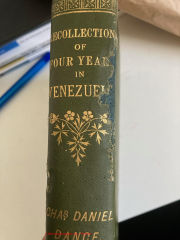
(Contemporary citation:
Dance, Charles Daniel. "Recollection of Four Years in Venezuela." In Nineteenth-Century Travels, Explorations and Empires, pp. 51-103. Routledge, 2021.
Reply by InspectApedia-911 (mod)
@Anonymous by private email,
This looks like deteriorating paper - storing the book flat in dry air is usually recommended.
If the book is valuable I'd ask for advice from a book conservator.
For the musty smell, exposure to warm dry sunny air can be helpful.Those white spots look like water damage.
Your first photo looks like deterioration and material loss of the binding and fragile material loss of some paper edges. I can't see mold in your photos.
If the book smells moldy that's another matter.
On 2022-06-09 by Jasmine -books bought online have a strong mouldy smell. Should I be concerned?
Hi, I recently purchased some books second hand (privately online), there's about 20 of them. When they arrived, some had a very strong mouldy/musty smell (as if they had been in a damp environment), but I dont see any visible mould growths.
Only one or two of the books have some discolouration inside the cover, but otherwise all seem in good condition other than the really strong smell (even in books without the discolouration).
Should I be concerned about mould growth in these books and possible contamination/spores? We don't have a mould problem in our house and we don't tend to get humid weather here. Is there anything I need to do to treat these books when I can't see any mould growth (such as wipe the covers or vacuuming them with our HEPA vacuum)?
I have been trying to remove the smell with bicarb soda in a plastic container but it has been nearly a week and the smell is still quite strong. I have also tried laying the books in the sun for an hour, being mindful of warping of the pages and covers, but it has made no difference.
I am just concerned that even though I can't see any mould growths, the problem will spread to other books/surfaces through spores if I put them in my bookshelf, even though the conditions are different/drier than how they were stored before. Will I always need to keep these books separately from the others?
Would wrapping them in plastic book sleeves help protect my other books?
I am a total newbie with dealing with this issue as I've never had books smell like this before, and am concerned for my other books, and about health issues through the spread of spores. Am I being paranoid?
Any advice would be appreciated (I have read through this article and the one about foxing but I'm just not sure if it applies to my situation as the books themselves don't seem damaged).
Thank you!
Reply by InspectApedia-911 (mod) - enclosing books in a box with bicarb of soda won't work
@Jasmine,
Best bet is to read through the moldy book advice above on this page as it's more complete than if I try to re-type that here.
I don't think enclosing books in a box with bicarb of soda will be sufficient to remove a mold contamination problem nor to deodorize the books as it doesn't do one iota of work to remove the odor or mold source. It's treating the symptom, not the cause.
Imagine standing in the kitchen holding a vacuum cleaner wand in the air: will it suck dust-bunnies from under the living room couch?
But heat and sunlight can reduce moisture, drive off or speed up off-gassing of MVOCs, and might help.
You might then try sun and fresh air exposure to see if that reduces the moldy smell from your books.
Lots of my books have mold and mildew: do I need to wipe each book page?
Lots of my books have mold and mildew. Have dried them out in the sun. Do I need to wipe clean each book or just the cover? There is also a layer of some sticky stuff on some of the book cover when I clean every year, what is that ? Mild ? It’s sticky abs have been cleaning it with a damp cloth as it’s greasy. Pl help - On 2022-02-03 by Shilpa Suchak
Reply by Inspectapedia Com Moderator - Do I need to wipe clean each book or just the cover?
@Shilpa Suchak,
The answer is ... as Mark Cramer says, "it depends"You will need to inspect and clean each book as described in the procedures above on this page. If the book's interior pages or cover are moldy then wiping the cover won't do the trick.
It also sounds as if you need to find and correct the moisture source. That may be the cause of the stickiness which could be a binder or adhesive or of course something else that we can't see from our remote location and with no more information about your books and how they are stored.
You're welcome to post a photo of these conditions. That may permit other comment.
Old book, re-bound but still smells mouldy - what can I do about it?
I have an old book (1926) that has been rebound but is still smelling very strongly of mould. Is there anything I can do about it? It makes me feel wuite ill when I try to read it. - On 2021-11-11
by Anonymous -
Reply by Inspectapedia Com Moderator
@Anonymous,
Take a look at the options given above on this page, starting with vacuuming and damp wiping and sun exposure.
Mold on University walls, they say throw out all myu books and papers: really?
my university office was closed up and not visited for 15 months. When I returned, there was mold grwoing on the walls. the university advised me to throw out books and papers as they would be contaminated.
I don't see mold on the books. But they in the offce for the entire 15 month. What do you suggest? - On 2021-09-13 by Marya
On 2021-09-13 by inspectapedia.com.moderator - books may look clean but smell moldy
@Marya,
If there's no visible mold on the books they may still have absorbed MVOC's, so might be a bit smelly.
I suggest taking books you particularly want to save, individually outside in the fresh air and examine them and smell them. If there's no visible mold and they don't smell of mold they're probably fine.
For books that have no visible mold but smell moldy you may be able to cure them by sunlight exposure, of course only in warm dry weather.
Other detailed advice is on this page.
Mildew on my old magazine collection - is it?
The articles I read that mention mildew seemed to perfectly match my issue with a couple old magazines I just bought.
There was an even, almost invisible layer of gray-ish white powder which under most circumstances I just would've assumed to be dust, but it was SO even and on all sides, including the back. as well as pages inside. It also smells terribly like mildew. Exactly like an old shower.
There are no green/black/gray spots anywhere, (hence why I bought these at first glance), just that fine dusty/powdery layer that is tricky to see. As I was flipping through, I started getting congested and got a headache. I immediately washed my hands, changed my clothes and took an allergy pill.
I am not allergic to mold, as per my allergy testing as well as dozens of other moldy books I've dealt with over the years of collecting. This is the first time I've had such a reaction to any antique items.
Do you think it could possibly be mildew somehow? Or is it just some rarer type of mold that I haven't encountered before? Thanks for any help! I'm most likely going to toss these, but I am curious for future encounters in case I stumble upon any more items with this smell/texture. - On 2019-11-25
by Pickles
Reply by danjoefriedman (mod) - mold contamination is not always visually obvious.
Thank you for the interesting remarks on moldy papers.
Indeed mold is not always visually obvious.
BTW it's mold not mildew. Mildew only grows on living plants.On 2020-02-09 by Miguel
@Pickles, this white dust might be DDT. I was told that back in the day some people thought it would be a good idea to apply DDT to books in order to remediate or prevent insect attacks.
Moldy Dr. Seuss books: how to clean them?
My mother stored some of my childhood books in her garage and not long ago there was a leak and some items were water damaged. I was looking through my totes the other day, none of which were water damaged, and noticed that a few of my Dr. Seuss books were molded.
Most were just on the exterior, but a couple also have mold on the edges of the pages. Keeping in mind the "rough" exterior of older Dr. Seuss books, what would be the best way to remove the mold. Regarding the molding on the edges of the pages, what might be the best way to remove that mold? - On 2019-02-23
by Autumn Pence
Reply by danjoefriedman (mod) - water-damaged books stored in mom's garage
My best advice, more thorough than an off-the-cuff reply here, is in the article above on this page, Autumn. Please take a look and let me know what questions remain.
...
Continue reading at FOXING STAINS on BOOKS & PAPERS or select a topic from the closely-related articles below, or see the complete ARTICLE INDEX.
Or see BOOK MOLD, CLEANING FAQs - questions & answers about the conservation of moldy books and papers posted originally at the end of this page.
Or see these
Recommended Articles
- AEROBIOLOGY ASSOCIATIONS
- ART CONSERVATION - Cultural Heritage and Aerobiology
- ARTWORK MOLD CONTAMINATION
- BIODETERIORATION AGENT & STAIN CATALOG
- BLACK LIGHT & UV LIGHT USES
- BOOK / DOCUMENT MOLD & WATER DAMAGE RESTORATION
- PREPARE TO CLEAN BOOKS / PAPERS
- HEALTH HAZARDS, MOLDY BOOKS
- DUST, TYPICAL LIBRARY SHELF CONTENTS
- BOOK-MOLD CLEANUP for DO-IT-YOURSELFers
- MAGAZINE MOLD CLEANUP for DO-IT-YOURSELFers
- MILDEW on BOOKS? - no, it's NOT mildew.
- BOOK CONSERVATION RESOURCES
- FOXING STAINS on BOOKS & PAPERS
- HOARDING HAZARDS
- MILDEW PHOTOGRAPHS BUILDINGS ?
- MILDEW REMOVAL & PREVENTION
- MOLD on PHOTOGRAPHS, CLEAN-UP
Other DIY mold cleanup references
- DO-IT-YOURSELF MOLD CLEANUP WARNINGS
- MOLD CLEANUP GUIDE- HOW TO GET RID OF MOLD
- MOLD CLEANUP - MISTAKES to AVOID
Suggested citation for this web page
BOOK / DOCUMENT MOLD & WATER DAMAGE RESTORATION at InspectApedia.com - online encyclopedia of building & environmental inspection, testing, diagnosis, repair, & problem prevention advice.
Or see this
INDEX to RELATED ARTICLES: ARTICLE INDEX to MOLD CONTAMINATION & REMEDIATION
Or use the SEARCH BOX found below to Ask a Question or Search InspectApedia
Ask a Question or Search InspectApedia
Try the search box just below, or if you prefer, post a question or comment in the Comments box below and we will respond promptly.
Search the InspectApedia website
Note: appearance of your Comment below may be delayed: if your comment contains an image, photograph, web link, or text that looks to the software as if it might be a web link, your posting will appear after it has been approved by a moderator. Apologies for the delay.
Only one image can be added per comment but you can post as many comments, and therefore images, as you like.
You will not receive a notification when a response to your question has been posted.
Please bookmark this page to make it easy for you to check back for our response.
IF above you see "Comment Form is loading comments..." then COMMENT BOX - countable.ca / bawkbox.com IS NOT WORKING.
In any case you are welcome to send an email directly to us at InspectApedia.com at editor@inspectApedia.com
We'll reply to you directly. Please help us help you by noting, in your email, the URL of the InspectApedia page where you wanted to comment.
Citations & References
In addition to any citations in the article above, a full list is available on request.
- American Institute for Conservation of Art and Historic Artifacts (AIC), 1717 K Street NW, Suite 200, Washington, DC 20006 Phone 202-452-9545 Website: http:/aic.stanford.edu/
- [1] Book Conservation, Department of Preservation & Collection Maintenance, Cornell University Library, Website: http://www.library.cornell.edu/preservation/operations/bookconservation.html - quoting:
Conservation staff will advise and assist the public with regard to water, mold or insect damage and offer advice on storage and environment. The book conservation unit is a resource for libraries, organizations, and individuals outside Cornell. The following book preservation publications are available to the public at the Cornell University Library website: http://www.library.cornell.edu/preservation/publications/index.html- Air Drying of Wet Books, Cornell University pamphlet, gives critical advice on how to handle books that have been wet. Original source: http://www.library.cornell.edu/preservation/publications/documents/AirDryingofWetBooks.pdf
- Disaster Response Plan, Cornell University Library, Disaster Subcommittee, Department of Preservation and Collection Maintenance, Security and Library Safety Working Group, Cornell University Library, Ithaca, NY 14583, Rev. July 2006.
Includes advice on preserving books following a disaster, storm, water, etc. including book drying and book cleaning methods following a water or flood disaster. - Pigment Particle & Fiber Atlas for Paper Conservators, Claire McBride, Getty Trust Postgraduate Fellow 2002, see http://www.library.cornell.edu/preservation/publications/mcbride.html [draft, incomplete, unedited] includes pigment atlases for Eastern pigments and fibers, Western pigments and fibers, and combined sources.
- Preserving Books in Your Home Library, Cornell University Library, original source: http://www.library.cornell.edu/preservation/publications/PreservingBooks.pdf
- [2] Book Conservation Internship Program, U.S. Library of Congress, see http://www.loc.gov/preserv/int_book.html
- Canadian Conservation Institute (CCI), 1030 Innes Road, Ottawa ON K1A 0M5, Canada, Tel: 613-998-3721, Website: http://www.cci-icc.gc.ca/html/
- Conservation on Line (CoOL), http://palimpsest.stanford.edu/
- [3] Frost, Gary, Teaching Book Conservation Methods Within a Training Program, The Book and Paper Group Annual, Vol. Five 1986, Book & Paper Specialty Group, AIC, Chicago 1986. Gary Frost, Asst. Professor, School of Library Service, Columbia University. Web-search 02/23/2011, original source: http://cool.conservation-us.org/coolaic/sg/bpg/annual/v05/bp05-13.html
- [4] Godsey, Joyce, Book Repair for Booksellers: A Guide for Booksellers offering practical advice on book repair, CreateSpace (April 22, 2009), ISBN-10: 1442137320, ISBN-13: 978-1442137325 [author is a bookseller trained in book conservation and repair].
- [5] Greenfield, Jane, The Care of Fine Books, Skyhorse Publishing; Reprint edition (September 1, 2007), ISBN-10: 1602390789, ISBN-13: 978-1602390782. Quoting from Amazon.com product description:
Jane Greenfield, advisor in rare book conservation at Yale University Library, is a leading authority on preservation and repair. After attending the New York School of Applied Design, she operated her own bindery for several years, enabling her to write from an unusual level of both education and experience. Here she offers a concise yet thorough discussion of book construction, storage, handling, cleaning, and repair, as well as essential expert advice on how to properly store and handle books of value in order to protect them from fire, flood, theft, and common wear and tear. With a new introduction by bestselling author Nicholas A. Basbanes, this is an indispensable volume for bibliophiles of every description. - [6] Guild of Book Workers, 521 Fifth Avenue, New York, NY 10175-0038, National Organization for all the Book Arts, Website: http://guildofbookworkers.org/
- Heritage Preservation (HP), 1012 14th Street, NW Suite 1200, Washington, DC 20005, Tel: 202-233-0800, Website: http://www.heritagepreservation.org/
- [7] Johnson, Arthur W., The Practical Guide to Book Repair and Conservation, [may not be available]
- [8] Lavender, Kenneth, Book Repair: A How-to-Do-It Manual (How-to-do-It Manuals for Libraries, No. 107) (How to Do It Manuals for Librarians), Neal-Schuman Publishers; 2 Sub edition (February 1, 2001), ISBN-10: 1555704085, ISBN-13: 978-1555704087 - Quoting:
Lavender's highly acclaimed guide has been completely revised and expanded to offer up-to-date help. Covering both basic book repair techniques and sound conservation practices, this completely revised step-by-step manual offers illustrated sections on cleaning, mending, hinge and spine repair, strengthening paperbacks, and more. Completely new chapters cover: wet and water-damaged books; mold and mildew; repair of book linings and pamphlet bindings; using acid-free materials to repair damaged books; lining paper objects; affordable repair tools and supplies and much more. A full discussion of when and how to make repairs, and alternative conservation practices that enable each librarian to develop procedures appropriate to his or her library are also provided. Here is the practical guidance you need to successfully perform archivally-sound repairs - even on a limited budget. - [9] McQueen, Sharon, Latorraca, Ellen, Warmbold, Richard, In-House Bookbinding and Repair, The Scarecrow Press, Inc. (September 26, 2005, ISBN-10: 0810852241, ISBN-13: 978-0810852242, Quoting:
In-House Bookbinding and Repair is a working document that contains information on setting up both a basic bookbindery and repair lab (i.e. the design, equipment, tools, and supplies needed) and instructions on rebinding and repairing cloth-bound books. Highly illustrated to greater enhance its usefulness, this manual also covers various aspects of book repair and conservation, and contains appendixes on manufacturers and suppliers of materials and products discussed in the text, an extensive Glossary of terms, a separate section on World Wide Web Resources, and a helpful bibliography. This manual will prove valuable to libraries of all sizes and locations. - National Park Service (NPS), Conserve-O-Gram [museum management series], Website: http://www.cr.nps.gov/
- NEDCC, "Preservation of Library & Archival Materials: A Manual", Northeast Document Conservation Center (NEDCC), 100 Brickstone Square, Andover, MA 01810-1494, Tel: 978-475-6021 Website: http://nedcc.org/
- [10] Rosenberg, Margot, Marcowitz, Bern, The Care and Feeding of Books Old and New, St. Martin's Griffin (March 1, 2004), ISBN-10: 0312326033, ISBN-13: 978-0312326036. [Authors are owners of Manhattan's Dog Lovers' Bookshop]
- [11] Schecter, Abraham A., Basic Book Repair Methods,
- [12] Swifter Sweeper Dry Sweeping Cloths, Unscented, [at Amazon, also at grocery stores, cleaning suppliers] [ Note: Amazon pays us a small pittance when items are purchased through the link above - Ed.]
- [13] HEPA Vacuum Cleaners, HEPA-Rated [at Amazon.com - Note: Amazon pays us a small commission on purchases through this store]
- C-Backpack HEPA 10 Q Vacuum Cleaner - HEPA (recommended for professional and large project book and library cleanup projects)
- Dustless Technologies 6-gallon HEPA Vacuum Cleaner (small shop vac size)
- Eureka 2694F Pet Lover Mighty Mite (floor canister - may be suitable for book cleaning)
- Eureka 4870MZ Boss Smart-Vac Upright HEPA< acuum Cleaner (upright)
- Hoover Platinum Upright Lightweight Vacuum Cleaner - HEPA (upright)
- Rigid WD1450 14-BGallon 6-HP Wet/Dry Vac - HEPA shop vac size), may be too powerful?
- Sunpentown V-8506 Bagless Upright Vacuum Cleaner (upright)
- [14] Verheyen, Peter D., Basic Paper Treatments for Printed Book Materials, presentation, Guild of Book Workers 9th Anniv. Seminar, Portland OR, 1989, web search 02/23/2011, original source: http://www.philobiblon.com/gbwarticle/gbwjournalarticle.htm Quoting:
Since these presentations and the synopses that later appeared in the GBW Newsletter, there has been some discussion. The presentations and these articles are not to be construed as a "how to" of basic paper conservation but rather as an introduction for those with interest but little experience. For the more experienced, they present the methods of the individual conservator for dealing with common problems. None of these methods is the only way to carry out a specific treatment. Each project has its own challenges and no two are alike. It is therefore important to continue to build our knowledge through both reading and the lessons of experience. - [15] Thanks to reader Mike Olsen for discussing the problem of how a lab can determine whether or not mold in a test sample is active or inactive - June 2010
- [16] Zotti (2011): M. Zotti, A. Ferroni, P. Calvini, "Mycological and FTIR analysis of biotic foxing on paper substrates", International Biodeterioration & Biodegradation
Volume 65, Issue 4, July 2011, Pages 569–578, [copy on file as Zotti_2011.pdf]
Abstract The small rusty stains (foxing) frequently found on historic paper documents, books, and prints have generally been analysed in the past by optical microscope through their morphochromatic appearance under visible light and UV radiation. Despite increased research efforts with more sophisticated techniques (mainly SEM and XRF), the biotic or even chemical origin of these stains remains unclear. The purpose of this paper is to verify to what extent a simple technique such as FTIR-ATR spectroscopy can be utilised for a clearer understanding of the controversial nature of foxing. Since this technique is sensitive to several organic chemical groups that are in common with both fungi and gelatine-sized ancient paper, some modern cardboards stained by biotic foxing have been selected for the analyses. The results clearly show the importance of FTIR and mycological analyses for the identification of residual microfungal agents, together with the by-products of their activity on paper substrates. Keywords: Archaeometry; Foxing; Moulds; Fungi; Paper biodeterioration; Paper composition. Corresponding author. Tel.: +39 0103099378; fax: +39 0102099377. Email: milla@klaatu.com.dist.unige.it - [17] Zotti (2008): Zotti, Mirca,Ferroni, Alice, Calvini, Paolo, "Inhibition Properties of Simple Fungistatic Compounds on Fungi Isolated from Foxing Spots", Restaurator [Restaurator. International Journal for the Preservation of Library and Archival Material] Volume 28, Issue 3, Pages 201–217, ISSN (Print) 0034-5806, DOI: 10.1515/REST.2007.201, April 2008, online publication, Summary:
Only few solvents and chemical compounds are employable for the reduction of acidity and fungi in aged paper documents. In this study, we tested the fungistatic properties of calcium propionate (already proposed as deacidificant) either in aqueous or ethanolic solution. Further, we compared the effect of this treatment with that of a commercially available fungistatic spray based on 4-hydroxybenzoate and propyl 4-hydroxybenzoate. One set of tests was performed on fungi isolated from foxed old paper samples. Another was performed on a sheet of glass that had recently covered a cardboard backing in a frame and that showed a one-to-one correspondence between the spawn on the glass and the foxing stains on cardboard. Ten species representative of filamentous fungi genera and one yeast form were identified. Of the fungal species, the one most frequently represented was Penicillium, with 5 different strains, while for each of the other genera there was only one species. The antifungal chemicals investigated presented different levels of effectiveness in inhibiting micro-organism growth: the results of a number of tests carried out on strains cultured in suitable media demonstrate that saturated solutions (3.5 g/L) of calcium propionate in ethanol significantly inhibit the fungal growing. - [17a] Zotti (2008): M. Zotti, A. Ferroni, P. Calvini, Microfungal biodeterioration of historic paper: preliminary FTIR and microbiological analyses International Biodeterioration and Biodegradation, 62 (2008), pp. 186–194
- [17b] Zotti (2007): Zotti, M., Ferroni, A., Calvini, P., 2007. Foxing biologico: diagnostica multidisciplinare. In: Atti del V Congresso Nazionale IGIIC e Lo stato dell’Arte e Cremona, 11e13 Ottobre 2007. Nardini Ed, Firenze, pp. 267e272.
- [18] Book Repair Guide, Bookcraft®, supplier of book, paper & photograph conservation and restoration supplies; archival storage advice, Tel. 1-800-448-6160 Website: www.gaylord.com, retrieved 9/1/12, original site http://www.gaylord.com/images/Bookcraft_BookRepairGuide.pdf, [copy on file as Bookcraft_BookRepairGuide.pdf] and sources recommended by Gaylord:
- [19] Banks, Paul N. & Pilette, Roberta, Eds., Preservation Issues and Planning, Chicago and London: American Library Association, 2000
- [20] Lavender, Kenneth and Stockton, Scott. Book Repair: A How-To-Do-It Manual, for School and Public Libraries. 2nd ed. New York: Neal Schuman, 2001
- [21] Lull, William P. with Banks, Paul N. Conservation Environment Guidelines for Libraries and Archives. Ottawa: Canadian Council of Archives, 1995, from the Canadian Council of Archives, 3444 Wellington St., Room 1009, Ottawa, Canada K1A 0N3
- [22] Ogden, Sherelyn, Editor. Preservation of Library & Archival Materials: A Manual. 3rd ed. Andover, MA: Northeast Document Conservation Center, 1999 (technical leaflets available online at www.nedcc.org)
- [23] Preservation of Library & Archival Materials: A Manual. 3rd ed. Andover, MA, Northeast Document Conservation Center, 1999
- [24] Young, Laura. Bookbinding & Conservation by Hand. Reprint edition. Newark, Delaware: Oak Knoll Press, 1995
- [25] Tronson, Paul, "Removing Foxing and Mildew", Bookbinding & Royal Bindings-Commissions Accepted-Worldwide, Canada, Email: paul@periodfinebindings.com, Tel: +1 250 580 1547, retrieved 9/11/12, original source: http://periodfinebindings.typepad.com/removing_foxing_and_milde/ [copy on file as Removing_Foxing_Tronson.pdf]
- [26] Coleman, M.H.; Baynes-Cope, A.D.; Agabeg, R.C., "Foxing", Chemistry and industry, Vol. 7, February 15, 1969, p. 197, three letters to the editor, quoting:
These three letters to the editor discuss removal of foxing stains from philatelic materials. Coleman recommends, in order of increasing severity, immersion in solutions of 1) 0.25% washing soda, 2) 2% chloramine T, 3) 2% sodium chlorite with 2.5% formalin, or 4) 5% potassium permanganate followed by 2% oxalic acid. Paper requires re-sizing. Baynes - Cope recommends early detection by ultra violet (UV) light, and removal by oxidative bleaching in hypochlorites. Test for color sensitive materials (eg. manuscript inks) or gums. Prevent foxing (microbiological attack) by maintaining humidity (RH) at 50-60% with good ventilation (air circulation), or interleaving pages with paper impregnated with orthophenyl phenol fungicide or its' sodium salt. Agabeg describes treatment of stamps using 1-5% chloramine T. Color sensitivity should be tested using a blank. Loss of original gum will reduce a stamp's value. This article is a reference for the conservation of library, archival and philatelic materials, and works of art (eg. prints, drawings) on paper. - [27] E. Sarantopoulou [Email: esarant@eie.gr] , S. Kobe,Z. Kollia, A.C. Cefalas, "Removing foxing stains from old paper at 157 nm", Applied Surface Science,
Volumes 208–209, 15 March 2003, Pages 311–316, Physics and Chemistry of Advanced Laser Materials Processing,
Abstract: Using a molecular fluorine laser at 157 nm foxing stains were removed successfully from a 16th century old paper. Laser cleaning of stains and foxing from old paper manuscripts is far more effective at 157 nm in comparison to different wavelengths without leaving any yellowish after-effect on the paper. This is because at 157 nm illumination of old paper, complete bond breaking of all the organic molecules of the paper is taking place. Mass spectroscopy at 157 nm and for moderate laser intensities up to 1 mJ/cm2 of old paper suffering from foxing indicate organic matter disintegration to small photofragments atomic, diatomic or triatomic, which are flying apart with supersonic speed. In addition high spatial resolution energy dispersive X-ray system (EDXS) analysis over the effected areas indicate the presence of iron, suggesting that biological activity is taking place preferentially in paper areas containing iron. - [28] S. Sequeira, E-mail: , E.J. Cabritab, M.F. Macedoc, "Antifungals on paper conservation: An overview", International Biodeterioration & Biodegradation
Volume 74, October 2012, Pages 67–86,
Abstract & Highlights: Since its invention, paper has become one of the main carriers of our cultural, scientific, political, economic and historical information. Given the importance of this material, its preservation is a matter of great interest. Paper can be deteriorated due to physical, chemical and biological agents. Within microorganisms, fungi are the major paper biodeteriogens. Throughout history, several methods have been used to prevent and stop fungal deterioration on paper based materials. In this work we present a review of the main chemical and physical methods used to avoid fungal paper biodeterioration until nowadays and also of some new approaches tested recently. The advantages and disadvantages of these methods are discussed as well as their health effects. Studies regarding antifungal compositions, methods of application, performance and effects on the treated materials are also presented with the aim of providing a clear set of conclusions on the topic.
The use of antifungals on paper conservation is reviewed. Performance and effects on the treated materials of each antifungal method are discussed. The advantages and disadvantages of the antifungal methods are compared. Composition, methods of application and health effects are described. Two tables summarizing the results are presented. - [29] Sabrina Manente Email: manente@unive.it, Anna Micheluz, Renzo Ganzerla, Giampietro Ravagnan, Andrea Gambaro, "Chemical and biological characterization of paper: A case study using a proposed methodological approach", International Biodeterioration & Biodegradation, Volume 74, October 2012, Pages 99–108,
Abstract: One of the most important causes of paper degradation is biodeterioration, caused especially by fungi and bacteria under certain environmental conditions. This study was designed to check the presence of cellulolytic microorganisms on documents from the 19th century, and to verify any biodeterioration that may have occurred by using a series of predominantly non-invasive analyses in order to preserve their integrity. For the characterization of paper documents various non-destructive micro-analyses were performed in succession, so as to deepen our knowledge of these step by step and thus provide a logical approach for the general study of this type of artifact. The samples were analyzed by using light microscopy, histochemical tests, pH analysis, SEM–EDS observations, Fourier transform infrared (FTIR) spectroscopy in ATR, and GC–MS. Organic cultures were also made with the samples taken from the surfaces of the documents; in particular, four fungal species, Aspergillus sp., Penicillium sp., Cladosporium sp., and Ulocladium alternarie, have been identified, as well as the presence of bacteria and dust mites. Finally, relations/correlations between the results of chemical and biological analyses are discussed.
Highlights: The biodeterioration of paper is caused especially by cellulolytic fungi and bacteria. Characterization of paper documents with non-destructive micro analyses. SEM–EDS, FT-IR in ATR, GC–MS and organic cultures. Isolated: Aspergillus sp., Penicillium sp., Cladosporyum sp., Ulocladium alternarie. - [30] High Definition Infra Red, The Truth About What You Thought You Knew, FLIR Systems, Inc., 27700 SW Parkway Ave., Wilsonville OR 97070, USA, Tel: 800-727-3547, Website: www.FLIR.com, retrieved 9/11/12, original source: http://gs.flir.com/uploads/file/white-papers/hd-infrared.pdf [copy on file as FLIR_hd-infrared.pdf]
- [31] Arai, H., 1984. Microbiological studies on the conservation of paper and related cultural properties: Part 1, isolation of fungi from the foxing on paper. Science for Conservation 23, 33e40.
- [32] Arai, H., 1987. On the foxing-causing fungi. Preprints of the ICOM Committee for Conservation.
- [33] Arai, H., 2000. Foxing caused by fungi: twenty five years of study. International Biodeterioration and Biodegradation 46, 181e188.
- [34] Arai, H., Nemoto, C., Matsui, N., Matsumura, N., Murakita, H., 1989. Microbiological studies on the conservation of paper and related cultural properties: Part 8, on the components found in foxing. Science for Conservation 28, 7e15.
- [35] Meynell, Guy, "Notes on Foxing, Chlorine Dioxide Bleaching and Pigments", Paper conservator, ISSN 0309-4227, Vol 4, No. 1, 01/01/1979 p. 30
- [36] Henry A. Carter, The Chemistry of Paper Preservation: Part 1. The Aging of Paper and Conservation Techniques, Journal of Chemical Education 1996 73 (5), p 417
Abstract: This study provides an introduction to the problem of the aging of paper and the conservation techniques that are currently being employed in paper preservation. The chemical reactions that are responsible for the aging of paper are discussed with the conclusion that acid-catalyzed hydrolysis is the predominant mechanism for cellulose degradation and strength loss. A description and the chemistry of a number of mass deacidification methods are presented. The more viable deacidification methods include the DEZ, Wei T'o, FMC, Bookkeeper, Viennese, Book Preservation Associates, Sable and the Batelle processes. A summary of the literature on the evaluations of these processes is presented, and the benefits and limitations of the mass deacidification methods are discussed. Other conservation techniques such as paper strengthening, conservation bleaching, and pest control are briefly introduced, followed by an introduction to alkaline papermaking. - [37] Henry A. Carter, The Chemistry of Paper Preservation: Part 2. The Yellowing of Paper and Conservation Bleaching, J. Chem. Educ., 1996, 73 (11), p 1068
DOI: 10.1021/ed073p1068, November 1, 1996
Abstract: The discoloration of paper on aging is of interest to the archival community and also to the pulp and paper industry where new and improved mechanical pulps are being developed. The yellowing of paper on aging can be attributed to the presence of chromophores found in some of the products formed from the degradation of one or more components of paper. This study identifies the nature of the chromophores found in cellulose, hemicellulose and lignin. The photooxidation of lignin-containing papers and the mechanism for photoyellowing are discussed. This is followed by a description of the basic principles of conservation bleaching which involves chemically treating papers in order to remove unwanted discoloration or stains. The washing of paper and the use of oxidizing and reducing bleaches are presented. The discussion on oxidizing bleaches includes hydrogen peroxide, alkaline hypochlorite, chlorine dioxide and sunlight. The chemistry of reducing bleaches focuses on dithionites and borohydrides. - [38] Henry A. Carter, The Chemistry of Paper Preservation Part 3. The Strengthening of Paper, Journal of Chemical Education 1996 73 (12), p 1160
Abstract: The following study describes the parylene and graft copolymerization processes that have been developed to strengthen fragile or brittle paper artifacts. Theparylene process involves vaporizing di-para-xylylene at 150o - 250 oC and splitting the dimeric parylene gas at 650o - 690 oC to mono-para-xylylene. The monomer vapor collides with the surface of the paper sample at room temperature and penetrates the cellulose fibers. Polymerization of the monomeric units to poly- para-xylylenes then occurs with the deposition of a thin uniform film. This parylene film forms mechanical links with broken fibers and strengthening occurs. The graft copolymerization (British Library) method involves treating papers with gaseous monomeric ethyl acrylate and methyl methacrylate, and initiating copolymerization by irradiating the papers with low intensity gamma rays. Webs of long-chained polymers are deposited on and between the cellulose fibers thereby strengthening the papers. The chemistry as well as modifications to both processes are discussed. - [39] Henry A. Carter, The Chemistry of Paper Preservation: Part 4. Alkaline Paper, Journal of Chemical Education1997 74 (5), 508
Abstract: The inherent instability of old papers is largely due to the presence of acids which catalyze the hydrolytic degradation of cellulose. The use of alkaline paper can minimize the problem of acidity for new papers. This study focuses on the chemistry involved in the sizing of both acid and alkaline papers and the types of fillers used. The waterproofing agent that is used in acid paper is alum-precipitated rosin size, which tends to spread and create a hydrophobic surfaces over the cellulose fibers. Alkaline paper uses the synthetic sizing agents, alkyl ketene dimers(AKD) and alkyl succinic anhydrides (ASA). These alkaline sizing agents become chemically bound to the cellulose fibers with hydrophobic chains pointing outward, producing a water repellent surface. The sizing reactions take place in a neutral-to-alkaline medium. Calcium carbonate can then be used as a filler to replace expensive titanium dioxide. Finally, the advantages and potential problems in alkaline paper making are discussed. - [40] Henry A. Carter, The Chemistry of Paper Preservation. Part 5. Permanent Paper
Journal of Chemical Education 2007 84 (12), 1937
Abstract: The acid-catalyzed hydrolysis of cellulose accounts for the deterioration of paper in library books and other written records. To combat this threat to our written heritage, new permanent papers have been developed that are relatively chemically stable and undergo a very slow rate of deterioration. Many of these new papers are manufactured from mechanical pulps that contain large amounts of lignin, and are stable when a calcium carbonate buffer is present. Based on the performance involving accelerated aging of the papers, the inclusion of lignin has been accepted in the standards for permanent paper by Canada and Germany, providing that a calcium carbonate buffer is present. Other countries are still reluctant to make the change in standards to include lignin. Research needs to be done to define optical properties and their requirements for the standards. The applications of the chemistry of paper preservation to teaching are also discussed. - In addition to citations & references found in this article, see the research citations given at the end of the related articles found at our suggested
CONTINUE READING or RECOMMENDED ARTICLES.
- Carson, Dunlop & Associates Ltd., 120 Carlton Street Suite 407, Toronto ON M5A 4K2. Tel: (416) 964-9415 1-800-268-7070 Email: info@carsondunlop.com. Alan Carson is a past president of ASHI, the American Society of Home Inspectors.
Thanks to Alan Carson and Bob Dunlop, for permission for InspectAPedia to use text excerpts from The HOME REFERENCE BOOK - the Encyclopedia of Homes and to use illustrations from The ILLUSTRATED HOME .
Carson Dunlop Associates provides extensive home inspection education and report writing material. In gratitude we provide links to tsome Carson Dunlop Associates products and services.


